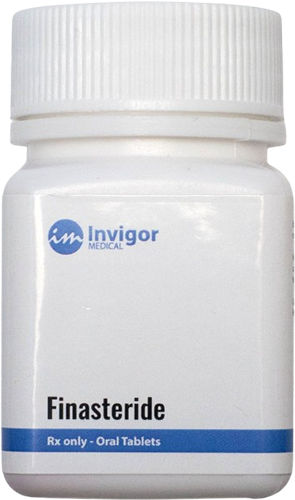Hair color and fullness have long been a symbol of youth and vitality. Many factors determine when men turn gray and lose their hair. Male pattern baldness, or androgenic alopecia, affects about 50 million men and 30 million women in the US. Finasteride, a medication that reduces hair loss and increases hair regrowth, works best when you are just starting to lose hair. So, while the causes of gray hair and balding are not completely understood, it is good to know when male pattern baldness will likely start.
Table of Contents
Male-Pattern Balding
Hair follicles are sensitive to the hormone dihydrotestosterone (DHT). An enzyme, 5α-reductase, catalyzes the conversion of testosterone to DHT. Finasteride is a competitive inhibitor of Type II 5α-reductase. By blocking 5α-reductase, finasteride reduces the amount of testosterone converted to DHT by up to two-thirds. Read more about what causes male pattern baldness or hair loss.
Several factors can affect the age at which you become bald, including:
- Genetic predispositions
- Sensitivity to DHT
- Skin conditions such as alopecia
- Poor nutrition
- Long-term stress
- Medication side effects
- Medical conditions
- Radiation therapy
- Chemotherapy

Graying Hair
Hair contains two types of melanin: eumelanin and pheomelanin. Eumelanin is more commonly found in black and brown hair and pheomelanin in red, auburn, and blond hair. However, combinations of these two pigments can give a wide range of hair colors. Melanin is produced by special cells called melanocytes. Once melanin is deposited in the hair shaft, it is slowly degraded over about 3.5 years. When melanocytes stop producing pigment, your hair will turn gray or white.
There is some evidence that stress may cause an abnormal and premature conversion of stem cells to melanocytes. Oxidative stress from waste products of cellular metabolism may also be a factor.
Besides long-term stress, other factors that may contribute to premature gray hair include:
- Genetic predisposition: Genetics play a large role in hair loss, perhaps accounting for as much as 80% of your risk of developing male-pattern baldness. In one study, 29 different single nucleotide changes in the genetic code were associated with an increased risk of male pattern baldness.
- A history of allergies or asthma: A history of atopy or allergies can increase the risk of hair loss.
- Radiation exposure: Radiation exposure can damage hair follicles.
- Vitamin B12 deficiency: In one study, researchers found that B12 deficiency can increase hair loss.
- Severe protein deficiency: Severe protein malnutrition can cause decreased hair growth and increased hair loss.
- Vitiligo: Vitiligo is a medical condition that can cause areas of depigmentation on the skin.
- Inherited medical conditions: Down’s syndrome and progeria are two examples of inherited medical conditions associated with premature aging.
- Endocrine conditions: Cushing’s syndrome, polycystic ovary syndrome, hyperthyroidism, and diabetes are all endocrine disorders that increase androgens and can contribute to male-pattern hair loss.
- Smoking: One study found an association between smoking and hair loss.
- Obesity: One study found an association between obesity and hair loss.

Before Age 20
Hair thinning can begin as early as age 6 to 8. However, childhood-onset hair loss is more common around age 13 to 18. Complete baldness would likely have a medical cause, but approximately 0.5 to 2% of teens will notice a receding hairline and hair thinning at the crown of their heads. Early-onset hair loss, like adult-onset, is due to sensitivity to DHT and miniaturization of hair follicles.
Age 20-30
About 20% of men will start to notice some hair thinning in their 20s. One study found that 16% of 18 to 29-year-old men had moderate to extensive hair loss.
Age 30-40
Approximately 30% of men will have some degree of hair loss by age 30. By the age of 35, two-thirds of men will have some degree of hair loss. Asian and Black men are less prone to hair loss than white men.

Age 40-50
In one study, 53% of men aged 40 to 49 had moderate to extensive hair loss.
Age 50-60
By age 50, about half of men will notice hair loss. Half of all women will as well, though the timing is typically associated with menopause.
Age 60-70
By age 60, about two-thirds of men will be bald or have significant balding.
After Age 70
Most Caucasian men will have male pattern baldness.
Solutions To Prevent Graying And Hair Loss
Though the exact cause of premature hair graying and hair loss is unknown, it is most likely a genetic predisposition. Optimizing your overall health is the best solution to prevent graying and hair loss.
- Maintain a healthy weight and lose excess pounds.
- Verify that you have adequate vitamin B12 levels.
- Stop smoking and avoid pollution to reduce the risk of metabolic damage.
- Consider treatment options such as minoxidil or finasteride.











